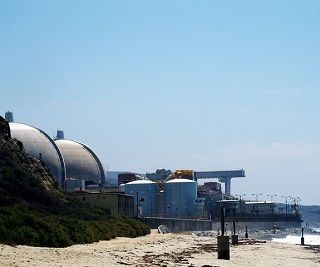Closing of One of California's Two Nuclear Power Plants Bears Mentioning
The no-nukes people are celebrating a considerable victory today out here in sunny California: the permanent closing of the San Onofre Nuclear Waste Generating Station. Anti-nuclear activist Ace Hoffman writes:
The letter that (senior vice president and chief nuclear officer for Southern California Edison) Pete Dietrich sent this morning to San Onofre employees suggests that the real reason SCE is closing San Onofre Nuclear Waste Generating Station is because of the Atomic Safety and Licensing Board’s involvement in the case. The ASLB would not be looking into the problems at San Onofre Nuclear Waste Generating Station if Friends of the Earth (FOE) hadn’t pushed the issue with carefully-planned legal actions.
FOE deserves enormous credit for their role in this event. Southern California narrowly avoided its own Fukushima on January 12th, 2012. Eight tubes in Unit three were worn enough to fail pressure tests, and one tube in Unit two was 90% worn. Unexpected vibration had done them in.
But with bullheaded determination, SCE tried to restart anyway. The 70% plan has been lingering around since nearly the beginning of the outage. Some restart plan, any restart plan. But first, FOE hired Arnie Gundersen to look into the matter, who is a world-renowned expert in steam generator technology, and then they hired a slew of other experts to confirm his findings. Independent experts, independent, that is, of SCE, NRC, and FOE also confirmed that SanO’s u-tubes were beyond repair. But Arnie did the hard discovery work first. Then he explained it again and again, to activists, reporters, and regulators. Arnie Gundersen is a hero to science and reason.
In another email, Hoffman writes:
I think Edison deserves credit for making a wise decision. I support the decision. It’s good for business, good for California, good for the environment. It’s the correct engineering decision to make. San Onofre was irreparably damaged by vibration.
Unfortunately we are now left with one of the largest, most concentrated nuclear waste piles on the planet. This will be an eternal problem, but thankfully it is no longer a growing problem and is becoming safer by the day. It will take millions of years — not just days — to be safe, but at least we are headed in the right direction.
The employees of San Onofre have been honorable opponents and I hope they all find jobs in the solar and wind technology energy sectors. However, the investigations should proceed, at the state level, at the federal level, and at the personal level, we should all continue to ask why nuclear power is used anywhere?
Diablo Canyon is next on my personal radar.
The reason that I wanted to chime in here is not that I’m rabidly anti-nuclear, but that I want to point out that Hoffman is completely correct: it was activism that caused this to happen the way it did. We must never forget the power we hold. As you’re reading these words, know that there are over 200,000 groups on Earth working on behalf of environmentalism and social justice. That’s a lot of horsepower, my friends, and it gets results.


That’s encouraging to read, and sad…
Encouraging to think we really can make a difference… Sad because in this case that potential to make a difference was wasted in replacing a GW of nuclear with some combination of coal and natural gas – so we’ve moved backwards in terms of environmental stewardship.
The nuclear waste is a non-issue. There’s ~3 square miles or so that we can’t use. That’s just not significant in terms of the bigger picture.
You presented this well Craig. Very balanced.
I often forget to mention that as I focus on whatever I disagree with.
Thanks, Glenn. Yes, that trade-off with fossil fuels is why I’m not “rapidly anti-nuke.”
Comparing San Onofre with Fukushima is at best disingenuous.
Failure of steam generator tubes would not cause a melt down. That is not to say that such a failure would be trivial, but it would, by an order of magnitude, be far less serious.